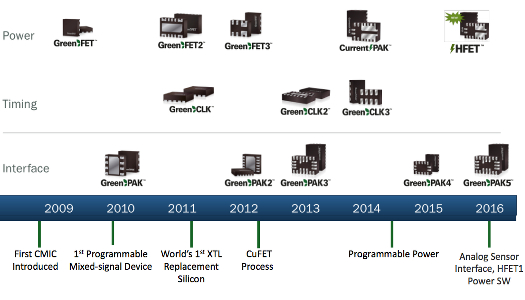
Silego scaling cost-effective agility in mixed-signal
But that is only just the start of what could be achieved according to CEO John Teegan who is now seeking additional application areas for the company’s mixed-signal ICs and a possible IPO.
The company was founded in 2001 and is still privately held, but with unit shipments expected to be about 600 million units in 2016 it has clearly reached significant revenue and apparently with no direct competitors. That said at least one company, Anadigm Inc. (Mesa, Arizona) has been around for many years selling field programmable analog arrays.
Silego’s offering is based on a one-time-programmable mixed-signal function array approach to analog, timing, some digital and power integration. Over the last several years the company has based its offering on a series of base die integrating a number of analog and digital functions. When put together with design software this allows users to develop custom circuits that are then characterized by way of on-die antifuse switches. Even though functions are analog they can be trimmed and checked physically for suitability in rapid order.
Silego and its customers get economies of scale through foundry partner TSMC and its 0.18-micron CMOS process used for the chips. Standard processing and packaging keeps part costs down in the 30¢ range, while prototyping can be iterated over a few days and production reached in weeks, the company states.
From the system designers’ perspective one part can eliminate multiple discrete components from the bill of materials and save square centimeters of PCB real estate, while saving cost and time to market.

A timeline of CMIC devices. Source: Silego.
That may sound like an unstoppable win but it all depends on there being a CMIC base device that supersets the system designers’ requirement. Choosing the right set of resources to include on a die has been what challenged the traditional field programmable analog array (FPAA) market. However, with 1300 design wins to date claimed across about 13 base die and a total of 2 billion units shipped, it is clearly not a problem that has affected Silego.
It is also an argument that persuaded semiconductor industry veteran Mike Noonen to join the company as vice president of sales and business development earlier in 2016 (see Silego signs Noonen to drive sales, marketing).
CEO John Teegan explains that for the first six or seven years of its existence Silego was a supplier of silicon clock chips to the PC and notebook computer industries. But that in about 2007 it became clear that Intel was going to integrate that function out of existence and that Silego needed to find alternative business.
What it was able to do was use its knowledge of the PC motherboard and its CMIC approach to sweep up discrete analog and digital components and hit significant volume with customers that already trusted the company. As a result most of the company’s progress to date has been made in the notebook and tablet computer space.
The CMICs sits below the microcontroller and are “no-code” devices that include op amps, comparators, counters, ADCs, pulse width modulation, simple digital logic up to the complexity of an asynchronous state machine and in some case power transistors. No passives are included as such but trimming of circuits is possible in the development kit.

GreenFET, GreenCLK and GreenPAK devices provide integration below the level of software programmability. Source: Silego.
The functions that can be implemented are many: motor and fan control, power sequencing, LED control, system reset, sensor interfacing, port detection and many more besides.
“We’re in the bulk of notebook and tablet computers,” said Teegan. Softness in the computing market over the last couple of years may explain Teegan’s eagerness to get into other markets. “It’s still a couple of hundred million units per year,” Teegan responded. “We’re also in some smartphones.”
But Silego is applicable generally where customers want integration, differentiation and where size and form factor can be important, Noonen said. “So that is battery-operated applications, wearables, IoT industrial applications,” said Teegan. Automotive is another sector where the strategy could play, said Teegan. For now Silego lacks the automotive qualifications necessary to gain design wins but they will come in time.
The most recent addition to the family of CMICs is the GPAK 5, which has expanded the range with the addition of an I2C block. The GPAK 5 I2C enables designers to read and change device configuration, such as analog comparator thresholds, on the fly. The GPAK5 includes I2C, analog comparators, digital logic and timing, 25kHz, 2MHz and 25MHz oscillators, an 8-state state machine in a 20-pin packagage measuring 2mm by 3mm.
Silego is already working with the likes of Nvidia, Qualcomm, Broadcom and Ambarella to improve reference designs by sweeping up peripheral circuitry on those companies reference boards.
Further base die are coming in 2017 along with chip-scale packaging, Teegan said.
Noonen pointed out that the fragmented nature of IoT was a great opportunity for Silego to offer its configurability and that smartwatches, fitness bands and virtual reality are all places where PCB real-estate is at a premium.
He added that packaging is likely to be another differentiator for Silego going forward. To date the company has used standard packaging but the potential of using 2.5D and 3D multidie packaging to combine digital and Silego mixed-signal devices could clearly create value. Configuration ASICs for MEMS components is another area where Silego does not yet sell but may in the future, said Noonen.
Teegan said that Silego has annual revenues exceeding $60 million and the company has been profitable since 2013. It would seem that the only thing that might prevent an initial public offering of shares in Silego would likely be a pre-emptive trade acquisition in these consolidating times.
Related links and articles:
News articles:
Silego signs Noonen to drive sales, marketing
1A load-switch comes in plastic package
 If you enjoyed this article, you will like the following ones: don't miss them by subscribing to :
eeNews on Google News
If you enjoyed this article, you will like the following ones: don't miss them by subscribing to :
eeNews on Google News



